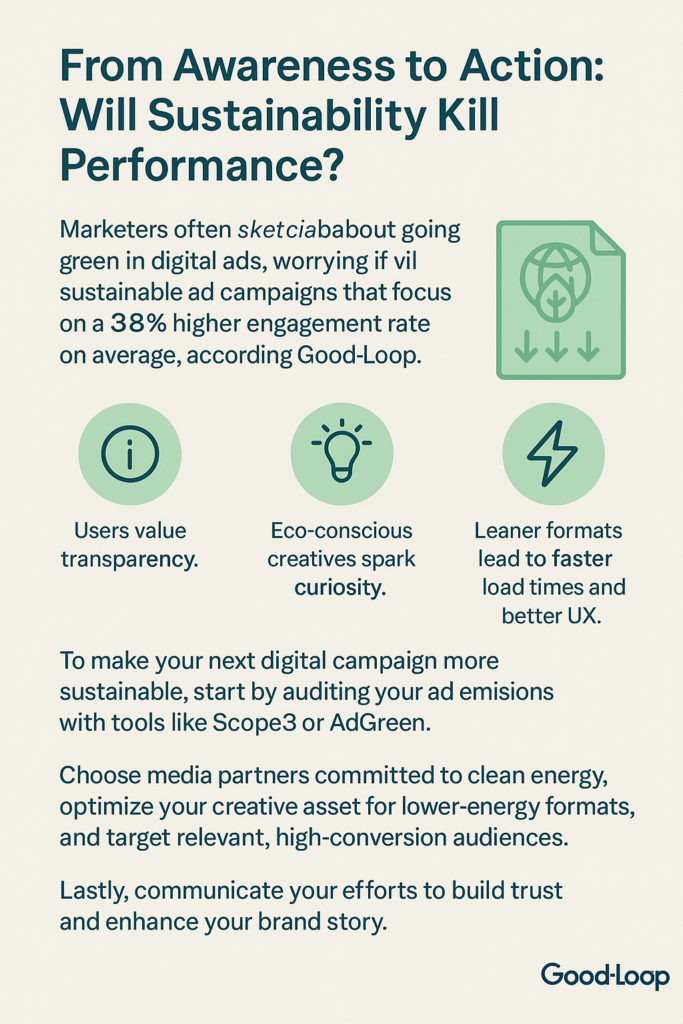
Can Digital Ads Go Green Without Sacrificing Reach?
Remember the day of blind scrolling? Ad pop-ups, blinking banners, and auto-played videos—we used to click them without giving them a second thought. Digital ads flooded our screens, but no one paused to ask: What’s the environmental cost of a single click?
Fast forward to now, things has changed. Today’s digital consumer is sharper, greener and way more intentional. Every scroll, action and stream are scrutinized, and brands are under pressure to walk the sustainable talk—not just on store shelves, but across screens. As sustainability becomes a non-negotiable, the digital ads that power our online world are being reimagined.
As sustainability moves from buzzword to baseline, the ad industry is facing a new frontier: making digital ads clean, conscious, and carbon aware. So, here’s the real question: can digital ads actually go sustainable?
Let’s dive into how brands are rethinking their ad game—and why your next campaign might need more than just a strong CTA. It might need a carbon label.
Hold on, do digital ads have a carbon footprint?
Surprise! Digital doesn’t mean carbon-free. In fact, the average digital ad campaign emits as much CO2 as a round-trip flight from London to New York. This might sound wild, but consider the sheer volume of what we’re dealing with:
- Every ad impression calls a server into action.
- Each video autoplay or display refresh requires energy.
- Real-time bidding (RTB) systems process trillions of transactions daily.
Data centers, content delivery networks, and programmatic platforms are all part of a vast, energy-hungry ecosystem. According to Scope3, a sustainability-focused ad tech firm, programmatic advertising accounts for 1% of global electricity consumption. That’s not a small change.
Meet the conscious clicker — a new kind of internet user that marketers can’t ignore
So, who’s fueling the shift toward sustainable digital ads?
This is a new generation of users who don’t just scroll, they scrutinize. They use ad blockers to cut digital clutter, choose brands that are upfront about their carbon footprint, and expect sustainability from every touchpoint—from packaging to pixels.
And they’ve got the numbers to back them. According to the PDI Business of Sustainability Index, 91% of Gen Z consumers prefer to buy from sustainable companies, and 77% are willing to pay more for sustainable products and services. These figures highlight the growing importance for brands to prioritize sustainability in their digital advertising strategies.
Sustainable by design: How digital ads are getting a green makeover
Making digital advertising more sustainable requires reconsidering how the system operates, not shutting it down. Here’s how the industry is evolving:
Carbon Scoring for Ad Campaigns
Platforms like Scope3, AdGreen, and Good-Loop now allow brands to measure the carbon emissions of their digital campaigns. Just like checking your flight’s carbon offset, advertisers can now track the CO2 output of every impression and video ad.
Think of it as a nutrition label—but for your CPM.
Choosing Low-Carbon Channels
Not all media is created equal. Ads on high-energy video platforms consume far more power than lightweight static ads or audio streams. Sustainable campaigns are leaning into:
- Audio ads (lower load, lower energy)
- Static creative formats
- Direct media buys with green-certified publishers
Smarter Targeting = Less Waste
Hyper-targeted ads not only convert better, they also reduce waste. Instead of carpet-bombing audiences, conscious marketers are trimming ad volumes and using AI-driven targeting to reach high-intent users efficiently.
Fewer impressions. Lower emissions. Better ROI.
Green Hosting and Creative Compression
Every asset hosted on an ad server consumes energy, so advertisers are now getting smarter—compressing creatives for quicker loads, hosting on green servers powered by renewables, and trimming excess code like tracking pixels and cookies. Even small tweaks, like optimizing GIFs, can make a big sustainability difference at scale.
Let’s talk about the brands leading the way
Some brands go beyond surface-level sustainability and embed it deep into their digital advertising strategies. As an illustration of how to be green without sacrificing reach, Ben & Jerry’s partnered with Good-Loop to measure, cut, and offset the carbon emissions of their campaigns. Patagonia continues to avoid programmatic advertisements in favor of carefully chosen, direct-buy media that support its environmental philosophy.
In the meantime, Unilever aims to achieve net-zero digital operations by 2030 and has incorporated carbon footprint indicators into its media strategy. More recently, Nestlé’s KitKat brand launched its first carbon-neutral campaign, optimized for lower-energy formats and backed by renewable-powered servers.
These brands are changing the norms and gaining the allegiance of environmentally conscientious customers without waiting for regulations.
From awareness to action: Will sustainability kill performance?
Marketers often question whether going green in digital ads will cost more or hurt performance. But sustainable ad campaigns focusing on carbon-light strategies are seeing a 38% higher engagement rate on average, according to Good-Loop. Why? Users value transparency, eco-conscious creatives spark curiosity, and leaner formats lead to faster load times and better UX. The goal is to redefine performance for 2025, not to compromise on it.

To make your next digital campaign more sustainable, begin by auditing your ad emissions using tools like Scope3 or AdGreen. Partner with media platforms prioritizing clean energy, optimizing your creative assets for low-energy formats, and focusing on high-intent, high-conversion audiences. Communicating your sustainability initiatives is crucial since it enhances your brand’s narrative and fosters trust.
What can we expect from carbon-neutral clicks in the future?
The road to sustainable digital advertising is just beginning. As regulations catch up and consumer demand intensifies, we can expect carbon labels on every campaign, “green premiums” for ad inventory on clean platforms, and industry-wide standards for ad emissions reporting. Sustainability in digital ads is no longer a fringe movement—it’s going mainstream, and fast.
Consumer behavior is changing as a result of the “conscious click”, and marketers who embrace this change will not only future-proof their strategies but also build deeper, more meaningful relationships with their audience.
Cut to the chase
Digital ads have long been the fuel of the internet. But now, they’re being asked to clean up their act. The good news? The technology, tools, and audience support are already in place. So, the next time your campaign goes live, ask yourself: is this just a click—or a conscious one?

